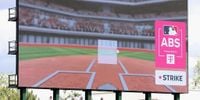The future of baseball is arriving faster than a 100-mph fastball—Major League Baseball (MLB) has officially voted to introduce the Automated Ball-Strike (ABS) Challenge System for the 2026 season, marking a historic shift in how America’s pastime will be played and watched. After years of speculation, testing, and debate, the league’s Joint Competition Committee—comprising six team owners, four active players, and one active umpire—reached a decisive agreement on Tuesday, September 23, 2025. The result? Robot umpires, or at least a technological backup for human judgment, are set to become part of every MLB game next year.
The journey to this moment has been anything but abrupt. MLB began experimenting with the ABS system in the Atlantic League and the minor leagues several years ago. In 2022, Triple-A teams started using the technology, and further tests followed during spring training and the 2025 MLB All-Star Game. These trials were crucial in shaping the final product, as they allowed players, coaches, and league officials to weigh the pros and cons of fully automated calls versus a challenge-based system. Ultimately, the challenge format won out, with players overwhelmingly preferring a system that keeps umpires in the game while providing a safety net for those critical, high-stakes calls.
So, how will the new ABS Challenge System work in practice? Each team will be allotted two challenges per game, and they’ll retain any challenge if it results in an overturned call. Only the pitcher, catcher, or batter may initiate a challenge, and they must do so immediately after the pitch—no help from the dugout or fellow players allowed. If a team runs out of challenges in regulation, they’ll be granted an extra one in each subsequent extra inning. The process is designed to be quick and seamless: once a challenge is made, the home plate umpire announces it to the crowd, and within roughly 15 seconds, the scoreboard displays the pitch’s location as tracked by ABS cameras, confirming or overturning the call.
The technology powering this system is impressive. Using Hawk-Eye, a system familiar to tennis fans, twelve cameras are strategically placed around each ballpark to monitor the pitch’s trajectory with pinpoint accuracy—down to about one-sixth of an inch. The strike zone itself is a two-dimensional rectangle spanning the 17-inch width of home plate. Its top and bottom are customized to each batter, set at 53.5% and 27% of the player’s certified height, respectively. This means every player will be officially measured during spring training to ensure their strike zone is fair and consistent throughout the season.
MLB Commissioner Rob Manfred praised the committee’s decision, stating, "Throughout this process we have worked on deploying the system in a way that’s acceptable to players. The strong preference from players for the challenge format over using the technology to call every pitch was a key factor in determining the system we are announcing (Tuesday)." He went on to commend the committee for "striking the right balance of preserving the integral role of the umpire in the game with the ability to correct a missed call in a high-leverage situation, all while preserving the pace and rhythm of the game."
The league’s decision wasn’t unanimous—some player representatives voted against the measure—but the six-owner majority on the committee ensured the proposal’s passage. The umpire’s union was also involved in the process, and the system’s implementation was collectively bargained and agreed upon in 2024. Bill Miller, the umpire representative, joined owners and players in Tuesday’s pivotal vote.
Not everyone is on board with the changes, however. The Arizona Diamondbacks offered a microcosm of the broader debate. Manager Torey Lovullo expressed support, saying, "I like it. Players just want to get calls right, have the calls made right. I know the umpires do their absolute best. They're not trying to miss calls. This game has changed over the past several years where the ball is traveling at an extremely high velocity, and there's calls that are missed. It's very natural in this game. They figured out a way to perfect it and get it right." Catcher Adrian Del Castillo welcomed the added layer of fairness, noting he would use the challenge system judiciously: "I'm not gonna do it when I'm 3-0 (count, as a hitter). I'm not gonna challenge a ball that was called a strike."
On the other side of the debate, Diamondbacks reliever Ryan Thompson voiced skepticism, arguing, "The more we transition into technology and away from America’s pastime, the game is just shifting. I just think the only reason why these things are being implemented is because of gambling. They want the certainty of, OK you’re putting money on this game, there’s no shenanigans involved. There’s no, ‘umpire made a mistake and that’s why you lost money.’ It’s clear-cut. This is how it is. It’s all about money." His comments reflect the concerns of traditionalists who fear technology could erode the human element that gives baseball its unique charm.
For fans, the reaction has been largely positive. In a recent survey, 72% of respondents said they felt either very positive or slightly positive about the impact of ABS technology on their experience at games. The league hopes the system will reduce the number of ejections—over 60% of which stem from disputes over balls and strikes in recent seasons—while still allowing for the drama and unpredictability that make baseball so compelling.
During this year’s spring training, teams averaged about four challenges per game, with a 52.2% success rate. Catchers led the way, overturning calls 56% of the time, while hitters succeeded 50% of the time and pitchers 41%. These numbers suggest that the system is both effective and efficient, correcting errors without bogging down the pace of play. The entire process, from challenge to resolution, is expected to take no more than 15 seconds—hardly enough time for fans to grab a hot dog before the next pitch.
Importantly, the ABS Challenge System isn’t about replacing umpires. Human officials will remain behind the plate, calling balls and strikes as they always have. The technology serves as a safety net—a way to ensure that the most consequential calls, especially in high-leverage moments, are as accurate as possible. As T-Mobile, a key technology partner in the rollout, said in a statement, the ABS system is "preserving the character of the game we love" while ushering in a new era of innovation.
As the league prepares for the 2026 season, anticipation is building. Will the ABS Challenge System revolutionize the way we watch and play baseball? Or will it simply add another wrinkle to a sport that thrives on debate and second-guessing? One thing’s for sure: the eyes of the baseball world will be glued to every challenge, every overturned call, and every moment when man meets machine on the diamond.
For now, players, coaches, and fans alike can only wait and wonder how this bold experiment will shape the future of the game. The countdown to robot umpires—well, sort of—has officially begun.


